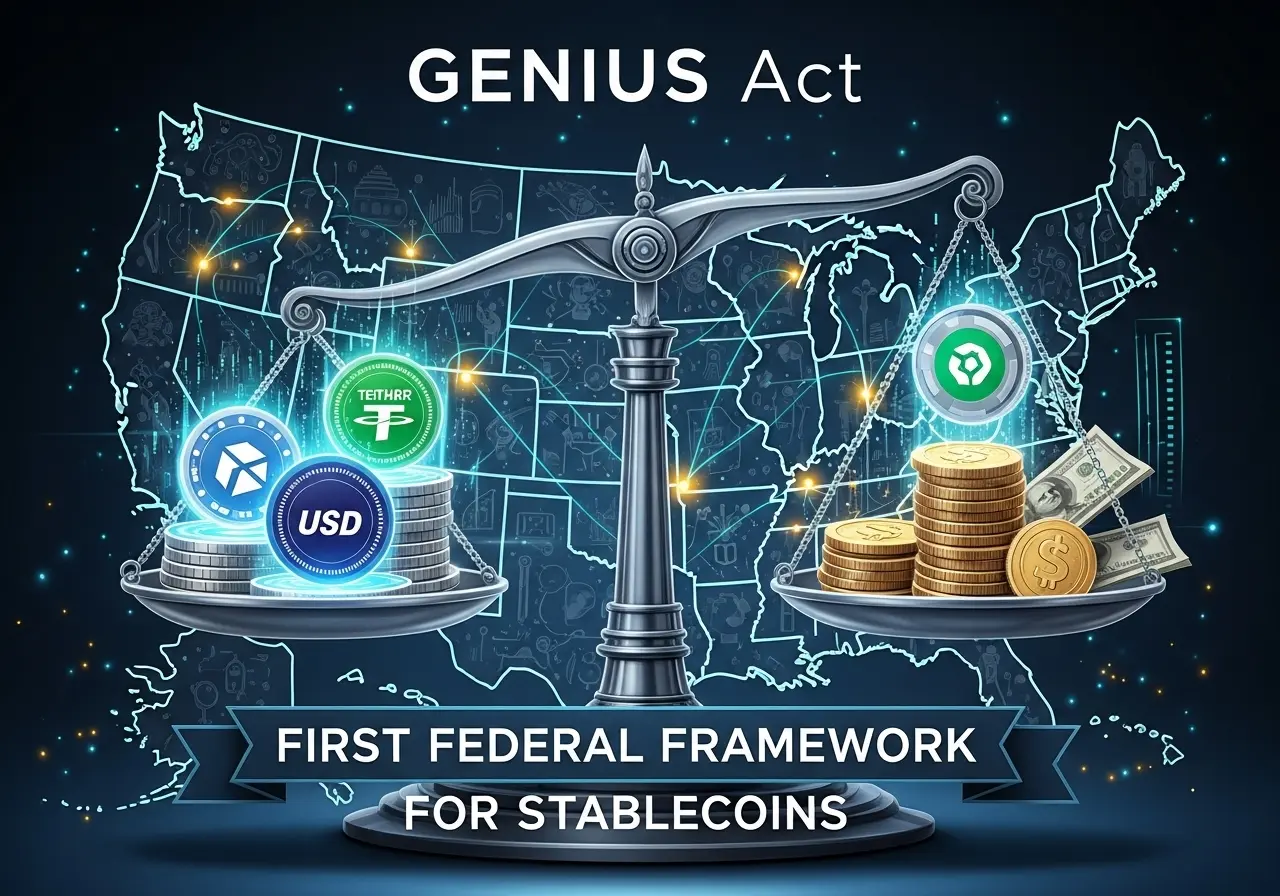In a landmark move for the digital asset industry, President Donald Trump signed the “GENIUS Act” (Guiding and Establishing National Innovation for US Stablecoins) into law on July 18, 2025. The signing marks the culmination of years of debate and establishes the first comprehensive federal framework for payment stablecoins in United States history.
Trump hailed the legislation as an “exciting new frontier” for cryptocurrency, with Vice President JD Vance reportedly helping push the legislation through with late-night phone calls, according to CBS News reports.
What is the GENIUS Act? A breakdown
The GENIUS Act creates a dual federal-state regulatory system designed to bring stability and oversight to the rapidly growing payment stablecoin market, which currently stands at $250 billion. The law aims to prevent the kind of collapses seen with earlier algorithmic stablecoins and ensure that digital dollars are as reliable as their physical counterparts.
Key Pillars of the Legislation:
Strict 1:1 Reserve Backing: At its core, the law mandates that every stablecoin must be backed one-to-one by US dollars held in segregated accounts or by high-quality liquid assets, such as short-term US Treasury bills. Issuers are required to publish monthly, audited disclosures of their reserves, a requirement praised by market watchdogs.
Comprehensive Licensing Framework: The act permits both bank-affiliated entities and nonbank fintech firms to issue stablecoins, but under strict oversight. According to industry analysis, large-scale issuers will be regulated at the federal level by the Federal Reserve and the OCC, while smaller firms may opt for a state-level licensing regime, creating a tiered system.
Enhanced Transparency & Stability Measures: The law introduces robust anti-money laundering (AML) and know-your-customer (KYC) requirements, bringing stablecoin issuers in line with traditional financial institutions. It also establishes clear standards for reserve management and ensures that in the event of an issuer’s insolvency, stablecoin holders have priority claims on the reserves, as detailed by financial media reports.
Why it matters for crypto and finance
The passage of the GENIUS Act is more than a regulatory update; it’s a foundational shift for the digital asset industry in the US and globally.
Historic Milestone for Crypto Regulation: After years of regulatory uncertainty and conflicting agency statements, this is the first coherent federal law specifically targeting a major segment of the crypto market. The House passed the legislation with a decisive 308-122 vote after initial conservative opposition was overcome. It provides a clear rulebook for an industry that has long requested one, notes CoinDesk.
Boosts Market Confidence and Adoption: The new clarity is expected to attract significant institutional investment. The legislation addresses the $250 billion stablecoin market specifically, while overall crypto market capitalization has reached historic highs of $4 trillion, driven by renewed confidence in the stability of the ecosystem’s foundational assets.
Strengthens Consumer Protection: By ensuring verifiable reserve backing and prioritizing holder claims in bankruptcy, the law provides a safety net for consumers and businesses using stablecoins for payments and savings.
Limits High-Risk Algorithmic Coins & Yields: The act explicitly bans non-collateralized (algorithmic) coins from being marketed as “payment stablecoins” and prohibits issuers from offering interest or dividends to holders. This is a direct response to past market collapses and aims to curb speculative financial products masquerading as stable assets.
Short-Term & long-term impact
The effects of the GENIUS Act will unfold over months and years, shaping both domestic and international markets.
Short-Term (Next 6-12 Months):
Regulatory Implementation: Federal agencies, including the Federal Reserve, OCC, and Treasury Department, will begin implementing detailed rules and technical standards based on the law’s framework, according to the White House Fact Sheet.
Market Adjustments: Major stablecoin issuers like Circle (USDC), Tether (USDT), and Paxos (USDP) will need to align their reserve management and operations with the new federal requirements. This could lead to shifts in their reserve compositions or operational changes to meet compliance standards.
Long-Term (1-3 Years):
Global Influence: The US has now set a global benchmark for regulating stable digital money. Other major economic blocs, such as the European Union with its MiCA regulation, and nations in Asia, will likely observe the US implementation and may align their own policies.
Institutional Integration: With a clear regulatory framework, traditional financial institutions are expected to accelerate their entry into the stablecoin space, potentially launching their own bank-issued digital dollars.
Innovation within Guardrails: While limiting algorithmic coins, the law provides a clear path for innovation in fully-reserved, compliant stablecoins, potentially spurring development in areas like programmable payments and DeFi integration.
Key provisions at a glance
| Provision | Summary |
|---|---|
| Reserve Requirements | 1:1 backing with USD or high-quality liquid assets; segregated accounts; monthly disclosures and audits. |
| Licensing | Federal oversight for large issuers; state-level option for smaller firms. |
| Consumer Protections | Mandatory AML/KYC rules; holder claims prioritized in issuer insolvency. |
| Restriction on Algorithmic Coins | Banned from being labeled or used as regulated “payment stablecoins.” |
| No Yields | Prohibition on paying interest, dividends, or other forms of yield to holders. |
What’s next?
The law’s passage marks the beginning of implementation. Federal regulators including the Federal Reserve and Treasury Department will develop detailed rules and technical standards, as outlined in official White House communications. Major stablecoin issuers must prepare compliance strategies, while the international regulatory community will closely monitor the US approach as a potential global model.
The GENIUS Act represents a pivotal moment, transforming stablecoins from a legally gray area into a regulated financial instrument within the United States. It’s a significant move aimed at protecting consumers, ensuring financial stability, and cementing the US dollar’s central role in the future of digital finance, as noted by financial analysts. As the detailed regulations take shape, the industry should prepare for a new era of compliance, increased institutional adoption, and a more mature and stable crypto ecosystem.
FAQ
Q: What is the GENIUS Act signed in 2025?
A: The GENIUS Act is the first US federal law regulating payment stablecoins, signed into law on July 18, 2025. It establishes a federal-state system requiring 1:1 reserve backing, regular audits, and clear licensing for issuers to ensure stability and consumer protection.
Q: How does the GENIUS Act affect algorithmic stablecoins?
A: The act effectively bans non-collateralized (algorithmic) stablecoins from being labeled or marketed as “payment stablecoins.” It also prohibits stablecoin issuers from offering interest or yield to holders, targeting models that contributed to past market instability.
Q: What is the immediate impact on the crypto market?
A: The law is designed to boost market confidence and protect consumers. The legislation specifically addresses the $250 billion stablecoin market, while the broader crypto market has reached $4 trillion in capitalization, indicating positive market reaction to regulatory clarity.
Q: Which companies are most affected by this new law?
A: Major stablecoin issuers like Circle (USDC), Tether (USDT), and Paxos (USDP) are directly affected and must ensure their operations and reserve management comply with the new federal framework. It also opens opportunities for US banks to enter the market.
Q: How did the GENIUS Act pass through Congress?
A: The House of Representatives passed the legislation with a strong 308-122 vote, overcoming initial conservative opposition. The Senate had previously approved the bill, with Vice President JD Vance reportedly playing a key role in building support.
Q: When will the GENIUS Act be fully implemented?
A: While signed into law, federal agencies will develop and finalize detailed regulations in the coming months. Full implementation timelines will be established as regulatory frameworks are completed.






